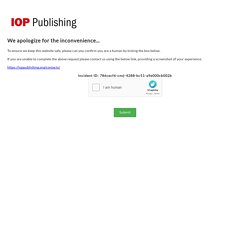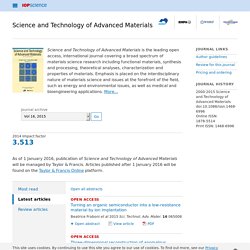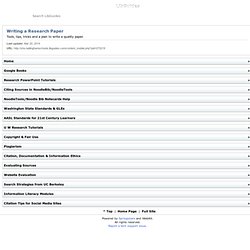

Scholar. Discover over 70,000+ databases and specially search engines. Choose the Best Search for Your Information Need. Sweet Search. NoodleTools : MLA / APA / Chicago Bibliography Composer, Notecards, Outlining. Users Guide. BibMe: Fast & Easy Bibliography Maker - MLA, APA, Chicago, Turabian - Free. KnightCite Citation Service. New Journal of Physics. Within the last two decades, quantum technologies (QT) have made tremendous progress, moving from Nobel Prize award-winning experiments on quantum physics (1997: Chu, Cohen-Tanoudji, Phillips; 2001: Cornell, Ketterle, Wieman; 2005: Hall, Hänsch-, Glauber; 2012: Haroche, Wineland) into a cross-disciplinary field of applied research.

Technologies are being developed now that explicitly address individual quantum states and make use of the ‘strange’ quantum properties, such as superposition and entanglement. Science and Technology of Advanced Materials. Solid State Ionics has its roots essentially in Europe.

First foundations were laid by Michael Faraday who discovered the solid electrolytes Ag 2S and PbF 2 and coined terms such as cation and anion, electrode and electrolyte. In the 19th and early 20th centuries, the main lines of development toward Solid State Ionics, pursued in Europe, concerned the linear laws of transport, structural analysis, disorder and entropy and the electrochemical storage and conversion of energy. Fundamental contributions were then made by Walther Nernst, who derived the Nernst equation and detected ionic conduction in heterovalently doped zirconia, which he utilized in his Nernst lamp. Search through over 11 million science, health, medical journal full text articles and books. PLOS ONE : accelerating the publication of peer-reviewed science.
DOAJ: Directory of Open Access Journals. Bioline International Official Site (site up-dated regularly) Microsoft Academic Search. CiteSeerX. Researching On the Web. Research. Information Source Evaluations for students. CARRDSS to evaluate your sources. Writing a Research Paper - EALR 1: The student understands and uses different skills and strategies to read.

Component 1.2: Use vocabulary (word meaning) strategies to comprehend text. GLE 1.2.2 Apply strategies to comprehend words and ideas. How do you spot fake websites.